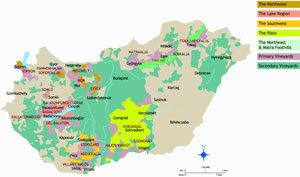Showing 1 to 12 of 12 (1 Pages)
Buy Wine from Hungary
For centuries Hungary has enjoyed a very unique wine and gastronomic culture, being a great defender of indigenous varieties and refined winemaking customs. Hungary
currently has almost 450 appellations divided into four major wine regions, which in turn are divided into 20 wine regions delimited by law.
 The characteristic wine of Hungary
The characteristic wine of Hungary
The most representative varieties in Hungary are Furmint and Hárslevelu (acid varietals) for the production of dry and sweet Tokaji wines. There is also the existence of other softer varieties such as the aromatic Leányka and Királyleánkya. Other varieties suitable for fresh wines without aging are Sauvignon Blanc and Irsai Olivér, while Chardonnay, Pinot Gris and Viognier
are more suitable for barrel-aged wines. Some somewhat unknown indigenous varieties are Kéknyelu, Ezerjó from Mór (rough), Mézesfehér (slightly sweet) and Juhfark from Somló (neutral).The red varieties in Hungary are in the minority and the vineyards are located in the departments of Eger (Northern Massif), Sopron (Northwestern Transdanubia) and Villány (Southern Transdanubia). The Kadarka variety produces correct table wines of early ripening. Kékfrankos gives good ripe wines with fragrant aromas. Pinot Noir, Merlot and Cabernet Sauvignon
are foreign varieties that over the years have conquered the wine scene.- ;
-
-
- ;
-
-
- ;
-
-
- ;
-
Buy Wine from Hungary
For centuries Hungary has enjoyed a very unique wine and gastronomic culture, being a great defender of indigenous varieties and refined winemaking customs. Hungary
currently has almost 450 appellations divided into four major wine regions, which in turn are divided into 20 wine regions delimited by law.
 The characteristic wine of Hungary
The characteristic wine of Hungary
The most representative varieties in Hungary are Furmint and Hárslevelu (acid varietals) for the production of dry and sweet Tokaji wines. There is also the existence of other softer varieties such as the aromatic Leányka and Királyleánkya. Other varieties suitable for fresh wines without aging are Sauvignon Blanc and Irsai Olivér, while Chardonnay, Pinot Gris and Viognier
are more suitable for barrel-aged wines. Some somewhat unknown indigenous varieties are Kéknyelu, Ezerjó from Mór (rough), Mézesfehér (slightly sweet) and Juhfark from Somló (neutral).The red varieties in Hungary are in the minority and the vineyards are located in the departments of Eger (Northern Massif), Sopron (Northwestern Transdanubia) and Villány (Southern Transdanubia). The Kadarka variety produces correct table wines of early ripening. Kékfrankos gives good ripe wines with fragrant aromas. Pinot Noir, Merlot and Cabernet Sauvignon
are foreign varieties that over the years have conquered the wine scene.




